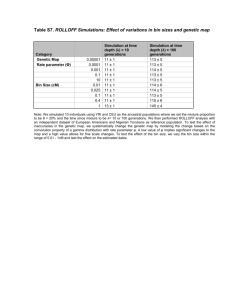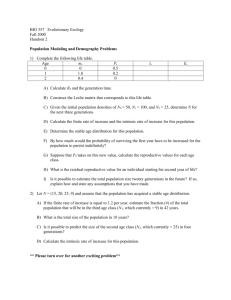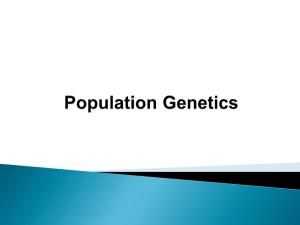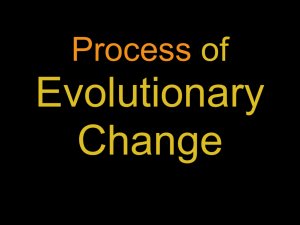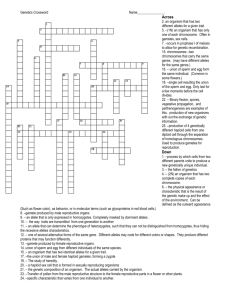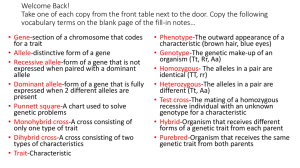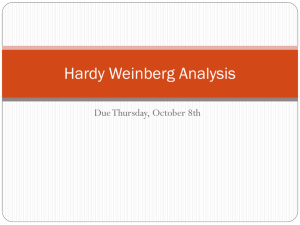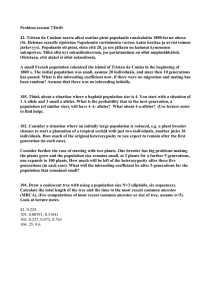bottlesim : a bottleneck simulation program for long-lived species with overlapping generations
advertisement
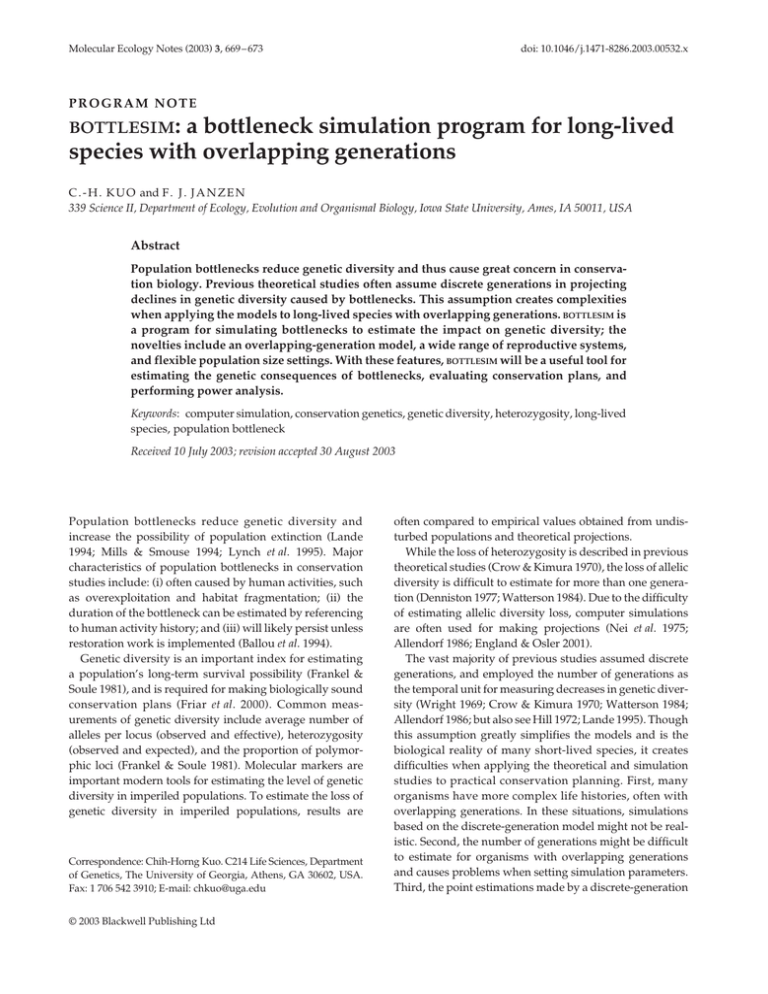
Molecular Ecology Notes (2003) 3, 669 – 673
doi: 10.1046/j.1471-8286.2003.00532.x
PROGRAM NOTE
Blackwell Science, Ltd
bottlesim: a bottleneck simulation program for long-lived
species with overlapping generations
C . - H . K U O and F . J . J A N Z E N
339 Science II, Department of Ecology, Evolution and Organismal Biology, Iowa State University, Ames, IA 50011, USA
Abstract
Population bottlenecks reduce genetic diversity and thus cause great concern in conservation biology. Previous theoretical studies often assume discrete generations in projecting
declines in genetic diversity caused by bottlenecks. This assumption creates complexities
when applying the models to long-lived species with overlapping generations. BOTTLESIM is
a program for simulating bottlenecks to estimate the impact on genetic diversity; the
novelties include an overlapping-generation model, a wide range of reproductive systems,
and flexible population size settings. With these features, BOTTLESIM will be a useful tool for
estimating the genetic consequences of bottlenecks, evaluating conservation plans, and
performing power analysis.
Keywords: computer simulation, conservation genetics, genetic diversity, heterozygosity, long-lived
species, population bottleneck
Received 10 July 2003; revision accepted 30 August 2003
Population bottlenecks reduce genetic diversity and
increase the possibility of population extinction (Lande
1994; Mills & Smouse 1994; Lynch et al. 1995). Major
characteristics of population bottlenecks in conservation
studies include: (i) often caused by human activities, such
as overexploitation and habitat fragmentation; (ii) the
duration of the bottleneck can be estimated by referencing
to human activity history; and (iii) will likely persist unless
restoration work is implemented (Ballou et al. 1994).
Genetic diversity is an important index for estimating
a population’s long-term survival possibility (Frankel &
Soule 1981), and is required for making biologically sound
conservation plans (Friar et al. 2000). Common measurements of genetic diversity include average number of
alleles per locus (observed and effective), heterozygosity
(observed and expected), and the proportion of polymorphic loci (Frankel & Soule 1981). Molecular markers are
important modern tools for estimating the level of genetic
diversity in imperiled populations. To estimate the loss of
genetic diversity in imperiled populations, results are
Correspondence: Chih-Horng Kuo. C214 Life Sciences, Department
of Genetics, The University of Georgia, Athens, GA 30602, USA.
Fax: 1 706 542 3910; E-mail: chkuo@uga.edu
© 2003 Blackwell Publishing Ltd
often compared to empirical values obtained from undisturbed populations and theoretical projections.
While the loss of heterozygosity is described in previous
theoretical studies (Crow & Kimura 1970), the loss of allelic
diversity is difficult to estimate for more than one generation (Denniston 1977; Watterson 1984). Due to the difficulty
of estimating allelic diversity loss, computer simulations
are often used for making projections (Nei et al. 1975;
Allendorf 1986; England & Osler 2001).
The vast majority of previous studies assumed discrete
generations, and employed the number of generations as
the temporal unit for measuring decreases in genetic diversity (Wright 1969; Crow & Kimura 1970; Watterson 1984;
Allendorf 1986; but also see Hill 1972; Lande 1995). Though
this assumption greatly simplifies the models and is the
biological reality of many short-lived species, it creates
difficulties when applying the theoretical and simulation
studies to practical conservation planning. First, many
organisms have more complex life histories, often with
overlapping generations. In these situations, simulations
based on the discrete-generation model might not be realistic. Second, the number of generations might be difficult
to estimate for organisms with overlapping generations
and causes problems when setting simulation parameters.
Third, the point estimations made by a discrete-generation
670 P R O G R A M N O T E
model leave large gaps between generations for long-lived
species. Most of the simulation programs available to population geneticists are designed under a discrete-generation
model e.g. easypop (Balloux 2001) and geneloss (England
& Osler 2001); for the ones that accommodate overlapping
generations, e.g. managedpop (Birnbaum et al. 2002) and
metasim (Strand 2002), constraints on population size
settings render those programs unsuitable for simulating
population bottlenecks.
bottlesim is a program specifically designed for simulating the genetic consequences of bottlenecks and postbottleneck population growth for long-lived species. In
addition to an overlapping-generation model, bottlesim
allows users to specify an arbitrary population size each
year. Compared to other programs that are limited to a
constant population size throughout the simulation (e.g.
easypop, geneloss, managedpop), this feature enables
users to simulate a wide range of scenarios (e.g. gradual vs.
rapid population decline, repeated bottlenecks, exponential vs. logistic population growth), provides a more realistic model, and eliminates the need to calculate effective
population size when population size fluctuates. Though
the harmonic mean of successive generations generally
provides a good approximation of effective population
size (Nei et al. 1975), significant deviations can occur if
populations experience cyclic changes in size (Motro &
Thomson 1982).
bottlesim also provides a wide range of reproductive
system settings. The reproductive system can be set to
asexual, monoecious (strict selfing, random mating with
selfing, and random mating without selfing), or dioecious
(random mating, single reproducing male each year, and
single reproducing pair each year). Sex ratio can be specified by users when a dioecious reproductive system is
chosen. In cases where reproductive skew is simulated, a
single reproducing male or pair is randomly chosen from
the population each year and reproduces all the new
individuals in that year. With these options and those
involving overlapping generations and population size,
bottlesim is expected to be a useful tool for population
and conservation geneticists.
The current version (version 2.6) of bottlesim includes
four simulation modules (single locus with constant population size, single locus with variable population sizes,
multilocus with constant population size, and multilocus
with variable population sizes). The diploid single locus
modules accept arbitrary allele frequencies at a single locus
and are intended for exploring the genetic consequences
of population bottlenecks under different settings. The
diploid multilocus modules accept multilocus genotypic
data of codominant markers, and are useful for evaluating conservation plans of different population sizes
based on the empirical genotypic data. The input files
must be ASCII text files (e.g. MS-DOS text or text-only);
the input file format is described in detail in the users’
manual.
User-defined parameters for simulations include the
degree of generation overlap (0–100%, 0 = discrete generations, 100 = completely overlapping generations), reproductive system, expected longevity of the organism, age of
reproductive maturation, population sizes, the number of
years to simulate, and the number of iterations. Observed
number of alleles and allele frequencies in the founder
population can be specified in the input file. All parameters
are only limited by the amount of memory available. Selection, migration, and mutation are not included in the
simulation model.
Each iteration starts by generating a founder population
with the population size, observed number of alleles and
allele frequencies specified by users. An age value is
assigned to each individual; the degree of generation
overlap specifies the percentage of individuals assigned a
random age value within the limit of expected longevity.
The age of individuals that are not assigned randomly is
set to zero. When the degree of overlap is set to zero, all
individuals start at age zero and reach the longevity limit
in the same year, resulting in a complete population turnover equivalent to a discrete-generation model. When the
degree of overlap is set to 100, all individuals in the population start with a random age value. The expected number
of individuals in each age group is (N/L), where N is the
founder population size and L is the length of expected
longevity.
Each simulation year includes two major temporal steps:
(i) from previous year’s end to current year’s beginning; (ii)
from current year’s beginning to current year’s end. In the
first major step, the program checks if population decline
occurs and generates a list of surviving individuals. Age of
all surviving individuals is increased by one. The second
major step includes three substeps: (i) identify the individuals that reach reproductive maturity and generate a
list of possible reproducing individuals; (ii) identify the individuals that reach the longevity limit, replace them with
new genotypes according to the reproductive system setting, and reset age to zero; and (iii) check if population
growth occurs and generate new individuals accordingly.
All genetic diversity measurements are calculated at the
end of each simulation year.
The output files generated by bottlesim are in ASCII
text format with space delimiters, and can be viewed
directly by word-processing software or imported into
spreadsheet software for any further analysis. The summary
output file contains all simulation settings, fixation probability, observed number of alleles (OA), effective number
of alleles (EA), observed heterozygosity (HO), expected
heterozygosity (HE), and the fixation index (F = (HE − HO)/
HE). The optional genotypic data output file contains the
raw genotypic data from the last year of each iteration. The
© 2003 Blackwell Publishing Ltd, Molecular Ecology Notes, 3, 669 – 673
P R O G R A M N O T E 671
Fig. 1 Validating the loss of heterozygosity. (a) Monoecy with random mating
(with selfing). Solid lines show the analytical expectations of Ht/Ho = [1 − (1/2Ne)]t,
where Ht is the heterozygosity after t
generations, Ho is the initial heterozygosity,
and Ne is the effective population size. (b)
Monoecy with random mating (without
selfing). Solid lines show the analytical
expectations of Ht/Ho = {1 − [1/(2Ne + 1)]}t.
In both (a) and (b), from top to bottom,
curves show bottlesim projections from
constant population size of 100 (), 20 (),
and 2 (). Other simulation parameters
were set as follows: degree of generation
overlap = 0, two alleles at equal frequencies, expected longevity = 1 year, age
of reproductive maturation = 1, number of
years simulated = 100, and number of
iterations = 1000 (error bars show the 95%
confidence intervals of iterations).
genotypic data output is in genepop (Raymond & Rousset
1995) format. Availability of raw genotypic data allows
users to perform power analysis of statistical genetic
tests.
To validate the simulation algorithm, we compared the
simulation output to analytical expectation for the loss of
heterozygosity (Fig. 1) and to another simulation program
(England & Osler 2001) for the loss of alleles (Fig. 2) under
the discrete-generation model. Excellent agreement was
found under all simulation settings tested. All validating
simulations were performed on an iMac with an 800-MHz
PowerPC G4 processor and 512 MB of memory. Each of
the validating simulations was completed within 1 min.
Figure 3 demonstrates the flexibility of the program,
including various settings of the degree of generation overlap (Fig. 3a), representative reproductive systems (Fig. 3b),
and fluctuating population sizes (Fig. 3c). One example
(Fig. 3c, ) also shows that using the harmonic mean as the
effective population size can lead to significant deviation
© 2003 Blackwell Publishing Ltd, Molecular Ecology Notes, 3, 669–673
when a population experiences cyclical changes in size
(Motro & Thomson 1982).
The source code of bottlesim is written in C++ programming language. All the pseudorandom numbers used
in the simulation process were obtained by using the
rand() function in the C++ mathematical library. The random number generator function is seeded with the starting
time of each run to ensure the uniqueness of each simulation. The source code, sample input files, users’ manual,
and compiled executables for Mac OS 9, Mac OS X, and
Microsoft Windows operating systems are available free of
charge at http://www.public.iastate.edu/∼fjanzen/.
Acknowledgements
This work was supported by grants from the Chelonian Research
Foundation Linnaeus Fund and the Society for Integrative and
Comparative Biology Grants-in-Aid of Research program to C-HK
and NSF IBN-0212935 to FJJ. We thank R. Fernando, G. Luikart, J.
Nason, L. Nunney, and M. Whitlock for helpful comments.
672 P R O G R A M N O T E
Fig. 2 Validating the loss of alleles. (a) Five alleles at equal
frequencies. (b) Five alleles at frequencies 0.6, 0.1, 0.1, 0.1, 0.1.
(c) Ten alleles at equal frequencies. Top curves show simulation result from a constant population size of 100 (bottlesim:
solid lines, geneloss: ). Bottom curves show simulation
results from a constant population size of 10 (bottlesim:
solid lines, geneloss: ). Other simulation parameters were
set as follows: degree of generation overlap = 0, monoecy
with random mating (with selfing), expected longevity = 1 year,
age of reproductive maturation = 1, number of years simulated
= 100, and number of iterations = 1000 (error bars indicating
95% confidence intervals are not shown because they are not
discernible).
Fig. 3 The loss of observed number of alleles under different
simulation settings. (a) Degree of generation overlap = 0 (), 50
(), and 100 (). Monoecy with random mating (with selfing),
expected longevity = 10 years, age of reproductive maturation
= 1, constant population size of 20. Note that higher degree of
generation overlap accelerates loss of alleles. (b) Representative
reproductive systems: asexual reproduction (), monoecy with
complete selfing (), dioecy with random mating (), dioecy with
single reproducing pair each year (). Degree of generation
overlap = 0, expected longevity = 1 years, age of reproductive
maturation = 1, constant population size of 20. (c) Fluctuating
population sizes: 90 generations of population size = 100 with
10 generations of bottleneck (population size = 10) in generation
1–10 (), generation 46–55 (), generation 91–100 (), and one
bottleneck every 10 generations (). The smooth line shows a
constant population size of 53 (approximation from harmonic
mean). Degree of generation overlap = 0, monoecy with random
mating (with selfing), expected longevity = 1 year, age of reproductive
maturation = 1. Other simulation parameters were set as follows:
10 alleles at equal frequencies, number of years simulated =
100, and number of iterations = 1000 (error bars indicating 95%
confidence intervals are not shown because they are not discernible).
© 2003 Blackwell Publishing Ltd, Molecular Ecology Notes, 3, 669 – 673
P R O G R A M N O T E 673
References
Allendorf FW (1986) Genetic drift and the loss of alleles versus
heterozygosity. Zoo Biology, 5, 181–190.
Ballou JD, Gilpin M, Foose TJ (1994) Population Management for
Survival and Recovery. Columbia University Press, New York.
Balloux F (2001) easypop (version 1.7): a computer program for
population genetics simulations. Journal of Heredity, 92, 301–302.
Birnbaum K, Benfey PN, Peters CM, Desalle R (2002) managedpop: a computer simulation to project allelic diversity in
managed populations with overlapping generations. Molecular
Ecology Notes, 2, 615 – 617.
Crow JF, Kimura M (1970) An Introduction to Population Genetics
Theory. Harper & Row, New York.
Denniston C (1977) Small population size and genetic diversity
implications for endangered species. In: Endangered Birds:
Management Techniques for Preserving Threatened Species (ed.
Temple SA), pp. 281–290. The University of Wisconsin Press,
Madison.
England PR, Osler GH (2001) geneloss: a computer program for
simulating the effects of population bottlenecks on genetic
diversity. Molecular Ecology Notes, 1, 111–113.
Frankel OH, Soule ME (1981) Conservation and Evolution. Cambridge University Press, Cambridge.
Friar EA, Ladoux T, Roalson EH, Robichaux RH (2000) Microsatellite analysis of a population crash and bottleneck in the Mauna
Kea silversword, Argyroxiphium sandwicense ssp. sandwicense
(Asteraceae), and its implications for reintroduction. Molecular
Ecology, 9, 2027–2034.
© 2003 Blackwell Publishing Ltd, Molecular Ecology Notes, 3, 669–673
Hill WG (1972) Effective size of populations with overlapping
generations. Theoretical Population Biology, 3, 278–289.
Lande R (1994) Risk of population extinction from fixation of new
deleterious mutations. Evolution, 48, 1460–1469.
Lande R (1995) Breeding plans for small populations based on the
dynamics of quantitative genetic variance. In: Population Management for Survival and Recovery (eds Ballou JD, Gilpin M, Foose
TJ), pp. 318–335. Columbia University Press, New York.
Lynch M, Conery J, Burger J (1995) Mutation accumulation and
the extinction of small populations. American Naturalist, 146,
489–518.
Mills SL, Smouse PE (1994) Demographic consequences of
inbreeding in remnant populations. American Naturalist, 144,
412–431.
Motro U, Thomson G (1982) On heterozygosity and the effective
size of populations subject to size changes. Evolution, 36, 1059 –
1066.
Nei M, Marayuma T, Chakraborty R (1975) The bottleneck effect
and genetic variability in populations. Evolution, 29, 1–10.
Raymond M, Rousset F (1995) genepop (version 1.2): population
genetics software for exact tests and ecumenicism. Journal of
Heredity, 86, 248–249.
Strand AE (2002) metasim 1.0: an individual-based environment
for simulating population genetics of complex population
dynamics. Molecular Ecology Notes, 2, 373–376.
Watterson GA (1984) Allele frequencies after a bottleneck. Theoretical Population Biology, 26, 387–407.
Wright S (1969) Evolution and the Genetics of Populations, 2: the Theory
of Gene Frequencies. University of Chicago Press, Chicago.
